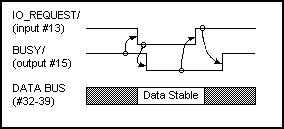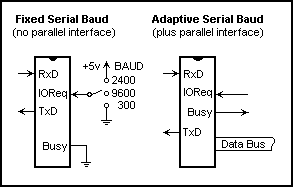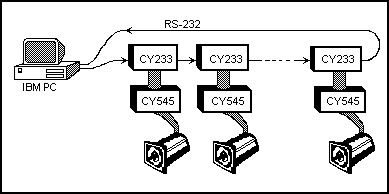CY545 Command Summary
Commands are upper case ASCII letters, followed by a space and argument value, as needed. Arguments without a suffix are single-byte values. Arguments with a "16" suffix are two-byte numbers and arguments with a "24" suffix are three-byte numbers up to 16777215. Multiple arguments may be separated by a space or comma.
A pos24 At position, sets current step position. B bit Bit set or clear of user selectable bits. C set Continuous step mode. D del16 Delay for specified milliseconds. E Enter following commands to external memory. F Rate specify First or starting step rate. G Go step. Starts relative mode stepping. H bit seek Home, using specified bit. I Initialize controller, perform software reset. J addr Jump to byte address of current memory page. L num24 set Number of steps for relative motions. M [invalid command] N num24 set Number of steps for relative motions. O mode set Operating mode of CY545. P pos24 step to specified absolute Position. Q Quit entering commands to external memory. R rate specify slewing or maximum step Rate. S slope specify acceleration/deceleration Slope value. T bit,addr loop to address Til bit matches value. U reserved. V reserved. W bit Wait for specified bit to match value. X eXecute external memory commands. Y addr16 set external memory address pointer. Z cnt16,addr ZillionLoop to byte address for 16-bit count. + set CW direction for relative motions. - set CCW direction for relative motions. / Negate prefix used with Bit commands. ? cmd Query specified command parameter value. 0 (ASCII zero) stop execution of commands from memory. [Addr,Cnt,D1,...,Dn special HP-display support command. "string" display all characters between quotes.
Command Interfaces
The CY545 supportd two basic command interfaces, a parallel interface and a serial interface. These signals are similar to functions on other CYxxx controllers from Cybernetic Micro Systems.
Parallel Interface
 The
parallel interface uses only two handshake lines, IO_REQUEST and BUSY/.
When you wish to send a command character to the CY545, you first check
that it is not busy; the BUSY/ signal should be high.
The
parallel interface uses only two handshake lines, IO_REQUEST and BUSY/.
When you wish to send a command character to the CY545, you first check
that it is not busy; the BUSY/ signal should be high.
Serial Interface
The Cy545 also provides a firect serial command interface, which may be connected to a host computer or terminal. Since the CY545 signals are all TTL voltage levels, external RS-232 line drivers and receivers must be provided, to translate the RS-232 voltage levels to the CY545 TTL levels. The serial interface may be operated in one of two ways, with the fixed baud rate, selected at power up, or with an adaptive baud rate, selected by two carriage return characters from the host.
The fixed baud rate mode is selected by tying the BUSY line low, so the CY545 will read it as a zero value on power up. The CY545 IO_REQUEST line value will determine the baud rate, based on an 11 MHz crystal, as follows:
F 9600
1 2400
0 300
The adaptive serial mode is chosen by default, when the BUSY signal is left floating, so the CY545 can drive it at power up. In this mode, the srerial baud rate is not set until the CY545 receives two carriage return codes. Be sure to send these characters after power up or any reset (hardware or software). Once the two carriage returns are receivedm normal CY545 commands may be sent.

The CY233 Network Control chip allows you to connect up to 255 devices to a single RS-232 serial communications line such as an IBM-PC COM1 or COM2 port, with the unique addresses assigned to each device. The CY233 Network is ideal for distributed systems where central control is required but very high speed communication is unnecessary.

Timing & Control Signals
The CY545 provides a simple I/O interface to any 8-bit parallel port ot a serial port.
![[Logo]](gif/smlogo2.gif) Cybernetic Micro Systems
Cybernetic Micro Systems
![PRODUCTS [Products]](gif/barprod.png)
![PRICES [Prices]](gif/barprice.png)
![SALES [Sales]](gif/barsales.png)
![COMPANY [Company]](gif/barcorp.png)
![HOME [Home]](gif/barhome.png)
